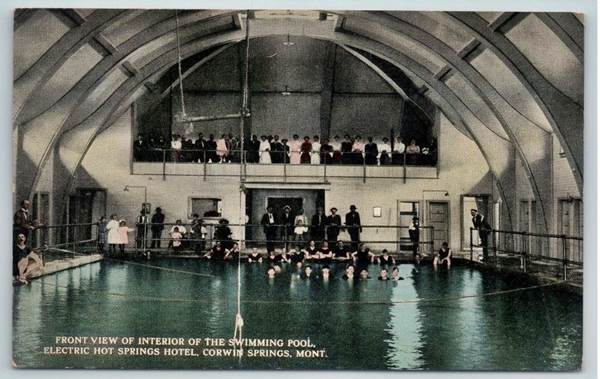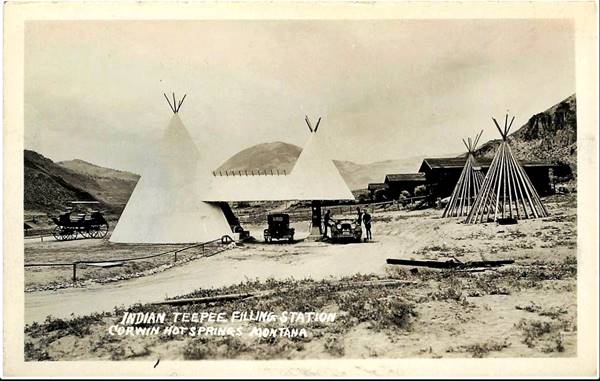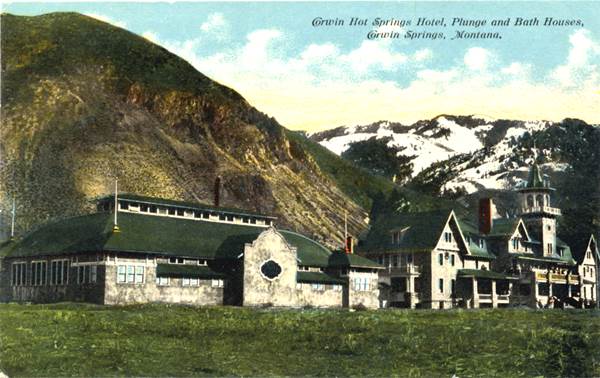History of Corwin Hot Springs Hotel & Resort
near Yellowstone's North Entrance

Copyright 2019 Robert V. Goss
All rights reserved. No part of this work may be reproduced or utilized in any form by any means, electronic or mechanical, including photocopying, recording or by an information storage and retrieval system without permission in writing from the author.
|
|
In 1908, Dr. F. E. Corwin, resident physician at Chico Hot Springs in Paradise Valley south of Livingston, contemplated building his own hot mineral springs spa in the fashion of those popular in Europe. He visited the hot springs at La Duke, some 7 miles north of Gardiner and shortly after purchased the rights to some of the hot water. In May 1908, Corwin formed the Electric Hot Springs Company with fellow investors. These included, Richard 'Dick' Randall (OTO Ranch), JW and CS Hefferlin (Livingston businessmen), and JH Holliday (Clyde Park hotelier & rancher), who together raised some $175,000 in capital.
Corwin Hotel under construction, 1909. Courtesy Yellowstone Gateway Museum
|
|
|
By December, Billings architects Link & Haire were completing the design plans for the Corwin Hot Springs Hotel, which was to include 72 rooms, a large swimming pool, private plunges, and Spray, Needle and Shower baths that were fed with hot water piped in from La Duke Springs. A contractor was hired and construction soon began. The hotel was to be advertised as a health resort and it was noted that the ". . . curative properties of these waters are of a superior quality, and are peculiarly adapted to the cure of rheumatic affections and the diseases of women . . ." The resort was sometimes referred to as the Electric Hot Springs Hotel.
Postcard View of Corwin Hot Springs Hotel & Bridge, Author Collection
|
|
|
|
The location was a mile or so was north of LaDuke hot springs and just east of the Yellowstone River. At that period of time, the only road to Gardiner and Yellowstone Park traversed the west side of the river. Park Country agreed to have a bridge built over the river for access, with the county and the new company splitting the $13,500 cost. The Northern Pacific RR, whose rails to Gardiner were also on the west side of the river, agreed to build a small depot near the bridge with a design in keeping with the style of the hotel.
LaDuke Hot Springs, approx 1902-1912. Swinging brige over river left-ccenter. Author's Digital Collection
|
|
The hotel was constructed to feature all the modern conveniences, including hot and cold running water in the rooms, along with electric bells, phones and electric lighting. The company built its own electric plant to provide for the hotel. Wooden pipes transported hot spring water from La Duke Springs for the plunge and for the hotel plumbing system. The hot water flowed continuously through the plunge, providing a complete change of water on an almost constant basis. The plunge featured vapor baths, private plunges, and tub baths. There were plans to build a hot house, heated by the spring water to provide fresh vegetables for the guests. Horse-drawn carriages carried the hotel guests to and from the railroad depot. A Butte newspaper headline in December of 1908 descried, “The Carlsbad of the Northwest,” a reference no doubt to the famed restorative springs in Bohemia. The "healing" waters at Corwin were claimed to helpful in the treatment of dyspepsia, stomach trouble, rheumatism, nervous ailments and other maladies.
Top Right: Corwin Hotel Plunge ca1912
Bottom Right: Corwwin Plunge in later years.
The roof was removed in the late 1920s
for an open-air plunge.
Author's Collection
|
 |
|
|
|
The resort opened around June of 1909 to great fanfare for Gardiner and Park County residents, and in time The resort also became popular site for conventions and social soirees.
Advertisements in January 1910, claimed, “You’ll see so much life and energy, that you’ll feel ten years younger in spite of yourself; you can live reasonable, have a good time and return home with a Clean Bill of Health.” Other ads proclaimed, “Spring is coming, and those old rheumatic pains are apt to begin chasing up and down your bones - better beat ’em to it. There’s a way - Take that trip to Corwin Hot Springs and boil out, before you’re down and out.”
1913 Ad for Corwin Hot Springs, Billings Gazette
|
1909 View of Hotel, bridge and rare image of the
Northern Pacific RR depot.
From Montana V.1, 1909. |
Close-up view of the Corwin Hotel, ca1909.
Author's Digital Collection
|
|
|
|
|
Postcard view of hotel porch.
Author's Collection |
Real-Photo postcard of the hotel parlor.
Author's Collection |
Postcard view of the hotel dining room.
Author's Collection |
|
However, despite local popularity and the traffic to and from Yellowstone, the resort encountered financial problems not long after the initial opening and by November of 1911, CH Hefferlin, a Livingston banker, acquired a controlling interest in the Electric Hot Springs Company. To help bring in business, ads were placed in the Bismarck (ND) Tribune during the winter of 1911-12, advising folks, “If you have a delicate wife or child, ship them to Corwin away from the blizzards.”
Nonetheless, during much of 1912 ads in newspapers featured “Reduced Rates” at the hotel for weekly and monthly guests to entice more business, and during the winter of 1912-13 the resort closed down operations completely. In late April of 1913, an ad in the Butte Miner newspaper announced, Corwin Hot Springs Hotel Reopens May 1st, 1913,” and touted, “A hot mineral water that CURES.” What specifically it cured was not mentioned.
|
|
|
The resort carried on the next few years, but again in the winter of 1916, it apparently closed up shop. Tragically, on December 1, the Livingston Enterprise published a startling headline,
“CORWIN SPRINGS HOTEL IS DESTROYED BY FIRE.”
The article continued, “The Corwin Hot Springs hotel, erected at a cost of $100,000, was totally destroyed by fire at an early hour this morning . . . The manager, Dr. Craven, was away at the time of the fire, and only the keeper was there.” The cause of the fire was not determined, but electrical wiring was certainly as possible culprit. CS Hefferlin boldly announced that he would rebuild with a modern fireproof structure with a number of modern cottages, but that plan never materialized. The nearby plunge survived the carnage, but the grand architecture of the hotel was forever gone.
Newspaper article from the Butte Miner, Dec. 1, 1916. The "T.S. Hesserlin" mentioned is actually Chas.S. Hefferlin of Livingsto, the major shareholder of the company.
|
|
Real-Photo postcard advertising the Eagle Nest Ranch Simming Pool, Clubhouse, and Cabins.
Author Collection
|
By June of 1920, the property had changed ownership and the new managers reopened the plunge and operated a small tourist camp on the site. In August of 1927, Walter J. Hill, son of Great Northern RR magnate James Hill, purchased the property along with another 20,000 adjoining acres. He invested several hundred thousand dollars in his new resort, rebuilding the swimming pool as an open-air plunge, building new 4-6 room cabins along the river, and erecting a club house with living room and dining room. It was named the Eagle’s Nest Ranch.
|
Real-Photo postcard showing the "Lounging Room" at the Clubhouse.
Author Collection
|
 Top: Corwin Teepee Gas Station ca1920s.
Top: Corwin Teepee Gas Station ca1920s.
Bottom: Nearby Corwin Sioux Village, ca1920s
Author's Digital Collection |
In 1926, Highway 89 was extended from Carbella Flats, just above Yankee Jim Canyon to Gardiner, on the east side of the river. So, to accommodate the increasing automobile trade, Hill constructed the unique Tepee gas station along the new road. Business continued on until 1944, when Walter Hill suddenly died of a heart attack at age 62. Early in 1946 a portion of the property was advertised “for sale.” It included a, “Ten-acre tract on main highway . . . [with] Six good-sized cabins, plunge, bathhouses and abundant supply of hot mineral water. Excellent fishing and hunting country.”
By 1947 Welch “Sonny” Brogan had acquired the property and eventually established what is believed to be the first elk game ranch and became something of the forefather of the modern game farm. By the time game farming became all the rage in the late 1970s and early '80s, Brogan had been at it for about 30 years. He estimated he sold more than 2,500 elk all over the world, sometimes fetching a top price of $5,000 each. Industry experts have said that herds at many of today's commercial elk operations can trace their lineage to Brogan's Cinnabar Game Farm
|
Ad from the Great Falls Tribune, Apr. 10, 1946
|
| CLICK HERE to view a later photo of the Teepee gas station |
CLICK HERE to view a photo of the Tipi Rock Shop
|
|
The Church Universal Triumphant eventually purchased the property in 1981 from Malcom Forbes and it became a part of the 12,000-acre Royal Teton Ranch. The leaders and followers made preparations for the upcoming end of the world. When the date for “the end” came and went and life continued on as always, there were a few followers, it seems, that were somewhat disappointed. But, that is a whole ‘nother story . . .
The pool walls, tattered plunge, and stone chimney of the old clubhouse still stand proudly, mute monuments to the once grand old Corwin Hotel.
|
 |
|
|
Postcard View Corwin Springs Hotel & Plunge, ca1913.
Author Collection
|
Corwin Springs Plunge, aerial view, 2014
Courtesy Google Earth
|
Corwin Hot Springs Plunge & New Bridg, 2014
The historic old bridge was removed in 2008 and replaced with a boring concrete structure.
Courtesy Google Earth
|
Copyright 2019 Robert V. Goss
All rights reserved. No part of this work may be reproduced or utilized in any form by any means, electronic or mechanical, including photocopying, recording or by an information storage and retrieval system without permission in writing from the author.
|